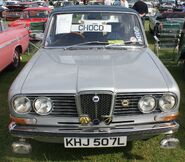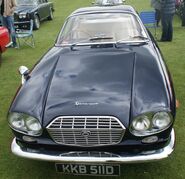
Lancia Flavia Zagato Sport
The Lancia Flavia is a medium sized luxury saloon, launched with a 1500 cc engine at the 1960 Turin Motor Show by Lancia and introduced in major European markets during the next twelve months. Coupe and cabriolet versions developed by Pininfarina quickly followed, together with one or two low volume 'specials' including an eye-catching Zagato coupe. Performance improved over the next ten years as the engine size increased, progressively, to 2000 cc. The car remained in production until 1970 when it was updated and renamed as the Lancia 2000.
In 2011, Fiat announced that the Chrysler 200 convertible would be sold in Europe by Lancia under the Flavia name beginning in the first half of 2012. However, it will remain branded as the Chrysler 200 in the UK and Ireland only.
Chronology[]
The Lancia Flavia was developed by Professor Antonio Fessia in the late 1950s, and introduced for sale in the UK in 1961. Initially available only as a four door saloon, it featured a 1.5 L aluminium boxer engine, Dunlop disc brakes on all four wheels, front wheel drive and front suspension by unequal length wishbones. This model was soon joined by a two door coupé, designed by Pininfarina on a shortened platform. Vignale built a two door convertible, while Zagato designed an outlandish-looking light weight two door sport version. The sport version has twin carburetors for extra power (just over 100 hp/75 kW), however this version of the engine was notoriously difficult to keep in tune. Even the single carburettor engine suffered from the problem of timing chain stretch. Sprockets with vernier adjusters were fitted to allow for chain wear and the cam timing was supposed to be checked every 6000 miles. Early cars also suffered from corrosion of the cylinder heads caused by using copper gaskets on aluminium heads, nevertheless the car was quite lively for its day considering the cubic capacity.
Later development of the engine included an enlargement to 1.8 L, a mechanical injection version using the Kugelfischer system, and a five speed manual gearbox. Towards the end of the sixties, when Fiat took control of the company, the Vignale and Zagato versions were discontinued. The coupé and saloon versions received new bodywork, first presented in March 1969 at the Geneva Motor Show.[3] The engine increased to 2.0 L in capacity, available with carburetor or injection, and four or five speed gearbox. The 2.0 L models were only made with revised Pininfarina Coupe and revised Lancia Sedan bodies.
Lancia 2000[]
The Flavia was revised and renamed the Lancia 2000 in 1971. The 2000 featured Girling disc brakes (replacing the Flavia 2000's Dunlop), Stainless steel bumpers and, for the fuel injected models, Bosch D-jetronic Analog-electrovalve fuel injection. These were built to 1973 or 1974 although brand new models remained in stock until 1975. As with the Flavia 2000, the 2000 was only made with Pininfarina Coupe and Lancia Sedan bodies.
Build and ride quality were superb, and the durability of these cars are excellent considering the relatively modest performance specifications. The meticulous engineering makes maintenance of these oldies simple, although it can be quite expensive due to the scarcity of parts.
Performance[]
The British "Motor" magazine tested a 1500 cc car in 1961 and found it had a top speed of 92.6 mph (149.0 km/h) and acceleration from 0-60 mph (97 km/h) in 18.6 seconds. A "touring" fuel consumption of 30.0 miles per imperial gallon (9.42 L/100 km; 25.0 mpg-US) was recorded. On the British market it cost £1499 including taxes of £688.
By 1967 the engine size had grown to 1800 cc. Testing a four door Flavia, rival Autocar magazine recorded a top speed of 103 mph (166 km/h), a 0-60 mph (97 km/h) time of 15.0 seconds and an overall fuel consumption of 30.0 miles per imperial gallon (9.42 L/100 km; 25.0 mpg-US). This put it behind the rival BMW 1800 TI for performance, though slightly ahead on fuel consumption. The testers commended the smoothness of the engine but found it lacked low speed punch. Overall they thought the performance pleasingly 'deceptive' because the car was 'faster than it feels'. The UK car market was still insulated by tariffs, but with the BMW 1800 TI retailing at £1498 and the Fulvia's recommended retail price now £1909, sales volumes were clearly not a Lancia priority. From the dominant UK domestic market player, the mechanically less sophisticated Ford Corsair 2000E was retailing at £1008.









